Blog
Archives
.
. . from 2015 to current
. .
FRIDAY
MARCH 13 - 2020
Spotted
Redshank
I got to Nore
Barn at about 11.00 with about 3 hours to high water
mainly to check on the Spotted Redshank. When I
arrived our friendly bird was roaming around the
saltmarshes to the west of the stream which was yet to
fill up with tidal water. It finally settled down in
the rapidly filling stream for a wash and preen before
getting down to the important business of feeding.
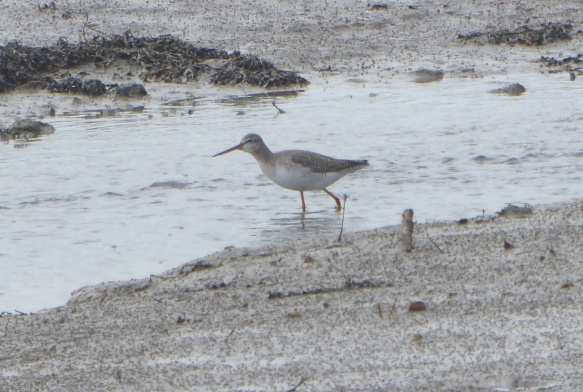
On the basis of
previous years I would expect the Spotted Redshank to
remain here for another week or so before making its
way back to its breeding grounds in Northern
Scandinavia. Bon voyage, my friend. See you again in
October maybe?
Video clip of the
Spotted Redshank preening . . . https://youtu.be/8GJ5rxAV0EE
For the full history
of this remarkable little bird please go to the
special page I have created for it at . . .
Spotted
Redshank at Nore Barn
Bird
Aware
It was good to
have a chat to Natalie, the ranger for Bird Aware, who
had a viewing post with scope at the end of
Warblington Road. Natalie has replaced Emily who has
now got a job with the RSPB. Today was the last of the
Bird Aware sessions in Emsworth for this winter,
though Natalie says they will be back in the autumn
for the next wave of wintering birds. I think Bird
Aware are doing a very good job in keeping visitors
abreast of local bird life and in particular enabling
local people to appreciate fully the wonderful bird
life they have on their doorsteps! Here is a shot of
Natalie looking for birds with visitors . . .

Sweet
Violets
On the way
back from Nore Barn I sopped briefly on Warblington
Road just past the junction with Valetta Park to have
a look at the magnificent crop of Sweet Violets
flowering on the grass verge. There must be hundreds
in flower. Here are just a few I snapped.

Great
Black-backed Gulls
I also popped
into Slipper Road to check on the Great Black-backed
Gulls which are now back on Slipper Millpond for their
9th year of nesting on the rafts. When I arrived at
about 12 noon both gulls were on the south raft where
they have nested for the past 3 years. Prior to that
they nested on the larger centre raft, but were ousted
by a pair of Canada Geese which nested there. So far,
I have not seen the Canada Geese on the pond, though
there was a pair last week on Peter Pond being pursued
by the resident cob swan.

While I was present
what I assume was the female gull flew to the centre
raft to collect a beak full of twigs. She flew off
with them probably heading for the south raft to start
a nest.
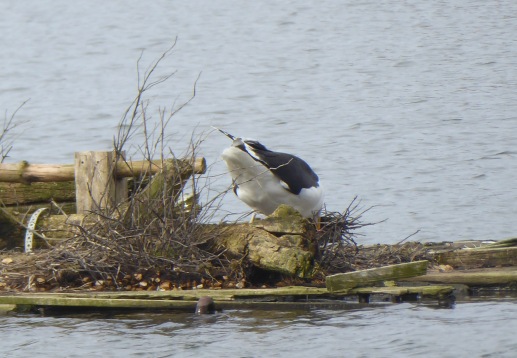
Video clip of Great
Black-backed Gull collecting nest material . . .
https://youtu.be/xjKeCN9h7lc
For the full history
of the nesting of these remarkable birds please go to
the special page . . . Great
Black-backed Gulls on Slipper Millpond
Brook
Meadow
There was a
positively spring-like feel to Brook Meadow when I
visited this afternoon. The sun was warm, the birds
were singing and it felt as if the meadow was coming
to life!
It was particularly good to hear the mellifluous tones
of a Blackbird wafting across the north meadow for the
first time this spring. Dunnocks were busily
displaying to each other. A Goldcrest and a small
flock of Long-tailed Tits were busily feeding in the
Cherry Plum tree on the causeway. Here is a Goldcrest
photo I dug out of the archives that Malcolm Phillips
took on Brook Meadow a couple of years ago.

One bird that did stay
still for a photo from me was the resident
female/juvenile Kestrel perched in a Black Poplar
tree.

The leaning tree with
roots partly exposed on the west side of the Seagull
Lane patch is a Blackthorn not as I previously thought
a Prunus.
CORRECTION:
My thanks to David Search for pointing out that
Blackthorn is a Prunus! Prunus spinosa.
I should have said it was not Cherry Plum
(Prunus cerasifera
'Pissardii')

It is now in full
blossom with attractive white flowers.
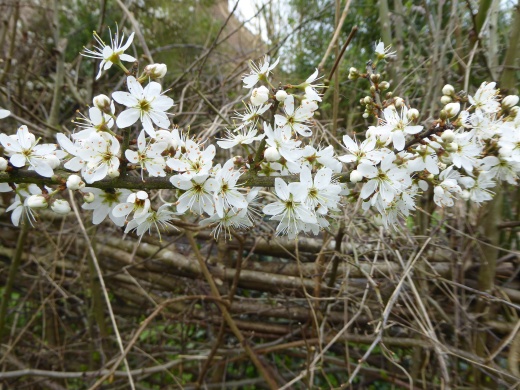
Leaves are now
starting to emerge on the Hawthorns on the Seagull
Lane patch. Leaves on Hawthorn always precede the
blossom, whereas in Blackthorn it is the other way
round.

There is a good stack
of logs near the river from the work of Maurice and
Terry earlier in the week.
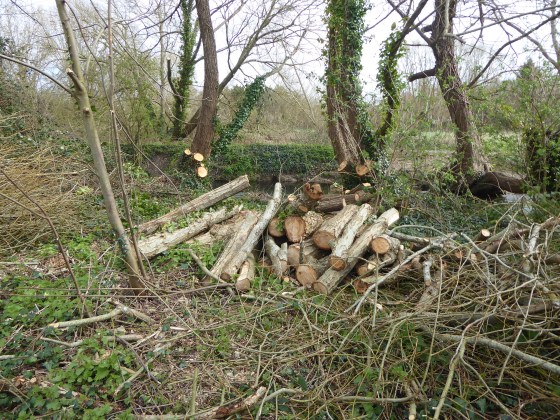
As I walked along the
main raised path, it was good to hear the rippling of
the river which is still flowering swiftly.
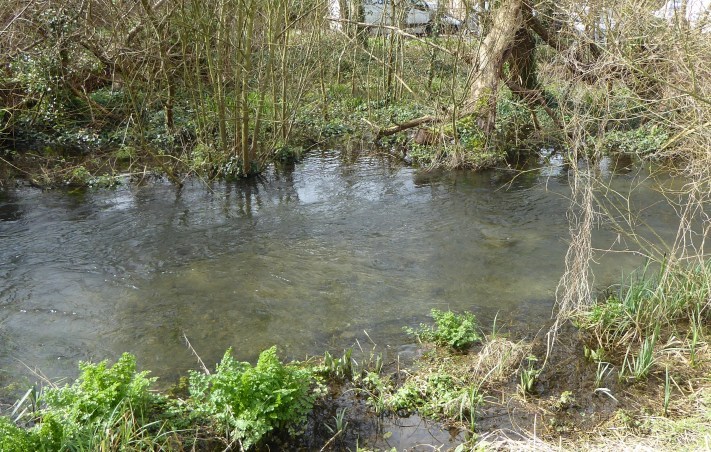
The river is still
bubbling over the sluice gate forming a stream of
water down the south path which remains closed, but is
not seriously flooded.

I was amused to see a
pair of Mallard clambering over the sluice gate.
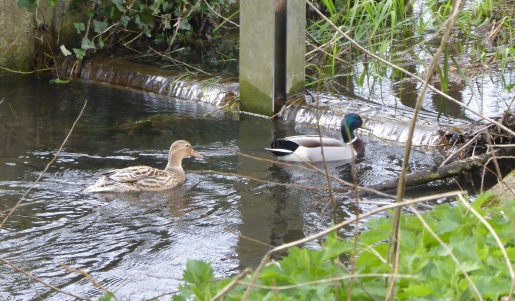
The Butterbur flower
spikes are growing fast, but so is the surrounding
vegetation which will soon cover the flowers. So I
shall have to do my annual count of the Butterbur
spikes very soon while they are visible.

The Osiers on the east
side of the north meadow are always the first of the
pussy willow catkins to show.
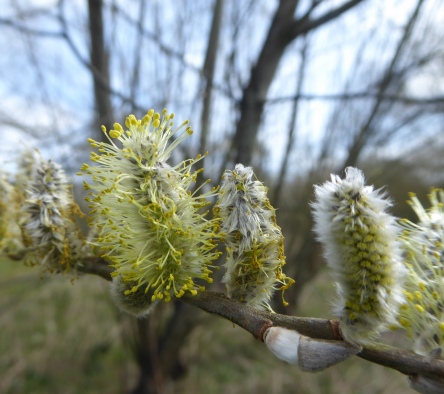
Reminder: Dan
and I will have to update the signcases in the coming
week.
Emsworth
Harbour
Peter
Milinets-Raby was out this morning for an hour from
9am to have a look around Emsworth Harbour. The
highlight was seeing the pond devoid of water for its
spring tide cleaning session.

The trickle of water
left had attracted 5 Little Egrets - one with fine
plumes developing.
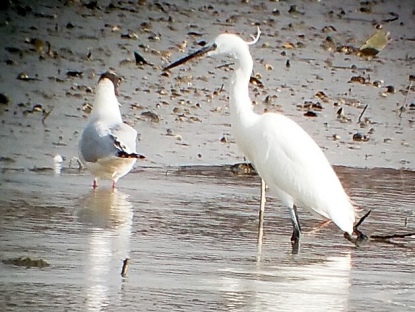
Off shore on the low
tide mud were 62 Mediterranean Gulls, 33 Brent Geese,
a single Greenshank and diving in the channel were 5
Red breasted Mergansers, 2 late Wigeon and 2 Shelduck.
Overhead there was an early sign of Migrational
movement with five flocks of Meadow Pipits going over
totalling 22 moving north west and inland.
Thorney
Island
Christopher
Evans had a walk down the west side of Thorney this
afternoon where he got a shot of a male Stonechat with
a caterpillar in its beak. That one looks scrumptious!

He also had a good
view of a pair of Great Crested Grebes doing their
ritual courtship display. Springtime joy!

THURSDAY
MARCH 12 - 2020
Great
Crested Grebe
At the end of
our walk round a very breezy town millpond this
morning, Jean and I were delighted to come across a
Great Crested Grebe swimming and diving in the harbour
beneath the quay. I managed to take a few photos in
between 20 sec dives. One can just see traces of
summer plumage starting to develop in the head and
body. What a super bird!

The Great Crested
Grebe is a large fish eating diving bird distinguished
by its sharp pink bill and dark crest which is often
flat on the head in winter. It is a moderately common
resident in our area and a winter visitor. It breeds
on fresh waters such as Chichester Gravel Pits where
one can see their ritualised head-waggling courtship
displays in spring. In winter new arrivals spread
around coastal water and millponds. There is usually
at least one Great Crested Grebe in Emsworth Harbour
and sometimes on the millponds during the winter
period.
WEDNESDAY
MARCH 11 - 2020
Warblington
Peter
Milinets-Raby was out in the gloom this morning for 90
minutes from 9am for a wander around Warblington. The
highlights were as follows:
Castle Farm fields: 13 Little Egrets, 4 Cattle Egrets
- all with a soft, warm wash of orange blush on the
crown and mantle

24 Med Gulls with 30
Black-headed Gulls. One of the Black-headed Gulls with
a summer hood was sporting a very pink flushed breast
- stunning.1 Kestrel
Big Field out east: 28 Brent Geese, 4 Skylarks - two
singing, 27 Linnets.
Straw dump: 2 Pied Wagtails, 1 Rock Pipit, 4 Water
Pipits - one with a smudged stain of pale pink on the
breast (they were disturbed by a Kestrel and at least
5 other pipits not seen departed off west!!!)
Conigar Point: 9 Wigeon, 41 Shelduck, 9 Brent Geese, 2
Med Gulls, 2 Red Breasted Mergansers.
Pook Lane: 26 Shelduck, 3 Red Breasted Mergansers, 52
Brent Geese, 2 Stock Doves.
Langstone
Mill Pond
Yesterday
Peter Milinets-Raby visited Langstone Mill Pond for an
hour from 9am - tide coming in. His report follows . .
.
Off shore. 11 Med Gulls, most either paired up and
displaying to one another or engaged in mutual
preening. Such beautiful birds.

1 un-ringed
Greenshank, 4 Common Gulls, 2 Teal, 11 Red Breasted
Merganser, 108 Brent Geese, 3 Shelduck with 38 off
Conigar Point. 2 Grey Plover, 1 Lapwing.
Pond: 1 singing Goldcrest, 1 singing Chiffchaff, 1
male and 2 female Tufted Duck.
Pair of Mute Swan still chasing young around the pond
trying to make them depart.
Flooded paddock: An amazing 27 Little Egrets, 5 Grey
Herons, 27 Wigeon, 47 Teal.
Grey Heron Heronry:
Nest 1: Adult sitting on nest. Unusual to be able to
see this nest, but with the storms foliage has parted
enough to reveal this nest.
Nest 2: Adult sitting on nest
Nest 4: Adult sitting on nest
Nest 6: Old nest being built up by a male in splendid
nuptial plumage
Nest 9: Adult sitting on nest
Nest 10: Adult sitting on nest
Nest 11: No activity around this nest site
Nest 14: Adult on nest, young heard begging for food
and two of the three young seen.
Nest 16: No activity around this nest. Shame after the
excitement of my last visit
Nest 17: Pair seen mating on the nest.
Sparrowhawk
Joyce Sawyer
had this magnificent Sparrowhawk in the tree at the
end of her garden in Denvilles. The picture was taken
through a window. Joyce hoped it might be the Goshawk
that mentioned in the blog on Sunday, but I think that
was wishful thinking on her part!!

TUESDAY
MARCH 10 - 2020
Spotted
Redshank
I popped into
Nore Barn at about 10am this morning. It was blowing a
gale and the tide was close to high water. But the
ever faithful Spotted Redshank was present in the
flooded stream, feeding nonchalantly on its own. I
took some photos and video clip which was not easy in
the strong wind.
The expected date of
departure of this iconic bird, now in its 16th winter
with us, is fast approaching; last year our last
sighting was on Mar 23rd which is in about 2 weeks
time. I shall keep checking, but would really
appreciate receiving any other sightings before it
leaves on its migration to its breeding grounds,
probably in Northern Scandinavia.
Video
clip of the Spotted Redshank at Nore
Barn . . .
https://youtu.be/VMJzuCntwDA
The special Spotted
Redshank page has full history of this remarkable bird
in Emsworth . . . Spotted
Redshank at Nore Barn
Stock
Doves in garden
I was very
pleased to see two Stock Doves in the garden this
lunchtime. This is my first sighting of Stock Dove in
the garden for a year; I had two at almost a year ago
on Mar 20th. They regularly seem to turn up at this
time of the year. Why is that?
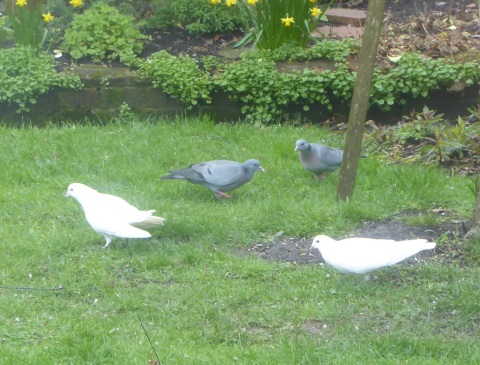
This year, as shown in
the photo, they came in with a pair of white doves. We
have had a flock of white doves in Emsworth for the
last couple of years, there used to be about 10, but I
think there are just two left. Apparently, they were
released at a wedding in St James Church and were not
recaptured and have been hanging around the church,
coming into local gardens to glean droppings from the
bird feeders.
Video
clip of the Stock Doves in the
garden . . .
https://youtu.be/AOBMRPHb8xs
MONDAY
MARCH 9 - 2020
Brook
Meadow
While on Brook
Meadow this morning, I came across Maurice Lillie and
Terry Lay on the Seagull Lane patch collecting up sawn
logs and branches from the recent tree surgery to
create a log pile. This is not a regular workday. Here
is Terry at work.

I stopped to admire
the interesting patterns of rings and cracks that had
been created on the sawn stumps.

I had a closer look at
the bracket fungi growing on a fallen Crack Willow
tree on the river bank that Terry had alerted me to
previously. I am fairly sure they are good examples of
Common Ganoderma (Ganoderma adsperum) - now
renamed Southern Bracket (Ganoderma australe).

Maurice and Terry had
already placed some of the sawn Willow stumps in an
attractive circle in the area of Frank's seat and the
Cherry trees on the west side of the north meadow.

The river is still
running very high and is brimming over the sluice gate
into the south meadow which remains impassable without
boots.

Here is a view of the
river looking north from the observation fence - the
banks are nicely clear of excess vegetation for the
time being, though this will change with the growing
season.

Hermitage
Millponds
The regular
pair of Mute Swans was on Peter Pond when I passed by
but with no sign of the Canada Geese that were present
on my last visit on Friday 6th. The other Mute Swan
pair was on Slipper Millpond with the cob standing
guard on the west path! It will be interesting to see
if both swan pairs manage to nest on the adjacent
ponds.

I was intrigued to see
the pair of Great Black-backed Gulls snoozing together
on the centre raft on Slipper Millpond. This will be
the pair that has nested on the pond for the last 8
years. For the past 3 years they have been ousted from
their preferred nesting site on the centre raft by a
pair of Canada Geese. It will be interesting to see if
this happens again this year.

Pussy
Willow
Coming back
home via Bridge Road car park I spotted my first
yellow catkins of 'pussy willow' emerging on the Goat
Willow tree on the wayside verge. Spring is here!

SUNDAY
MARCH 8 - 2020
Stansted
East
Jean and I had
a pleasant walk through the eastern section of the
Stansted Estate this morning. The weather was breezy
with a few blustery showers at the end of the walk. On
the way we stopped just inside the main entrance to
admire these Beeches supporting a luxuriant growth of
lime green moss around their bases.

Further along the main
tarmac road near the Iron Gate Cottages we came across
a number of large mature Ash trees that had been
felled beside the road.

The notice from Head
Forester Michael Prior explained that these trees had
to be felled as they were affected by Ash die-back
disease and were starting to drop dead branches,
thus becoming a hazard to walkers and workers on the
estate. He says large areas of Ash will need to be
felled across the estate and an expensive replanting
programme undertaken. He urges anyone who would care
to sponsor the replanting of trees to contact the
estate office on 02392 412265.

Continuing along the
track to the east past the Iron Gate Cottages we met
up with my old friend Dave Mead who was leading a
group of birdwatchers possibly from Portsmouth RSPB. I
had not seen him for a while. He told me they had seen
a pair of Goshawks, rare birds indeed, but
known on the estate. I assume they are in addition to
the pair in Southleigh Forest - Hollybank Woods.
Here's a photo I got from the internet.

There was plenty of
Blackthorn in flower along this track - our
first of the year. The flowers are much smaller than
those on the similar Cherry Blossom and lacking the
leaves which are already sprouting on the latter.

Bird
Populations in the UK
The British
Trust for Ornithology has published the latest
assessment of the size of bird populations in the UK.
The population estimates presented in the report
indicate that there are now thought to be about 85
million breeding pairs of birds in the UK. Wren
continues to hold the title of our commonest breeding
bird with 11,000,000 pairs, followed by Robin
(7,350,000 pairs), House Sparrow (5,300,000), and
Woodpigeon (5,150,000). Chaffinch and Blackbird share
the number five spot at 5,050,000 territories each.
Turtle Dove numbers have dived from 75,000 pairs in
1997 to just 3,600 pairs. The Chaffinch breeding
population has also fallen by 1.15 million pairs since
the last report seven years ago.
You can see the full list at . . . https://www.bto.org/sites/default/files/publications/apep4-population-estimates-birds-great-britain-uk-2020.pdf
Chaffinch
in Garden!
Yesterday, I
was astonished to see a Chaffinch (male) in the
garden for the first time for a whole year! He did
not stay long enough for a photo, so here's one I got
a few years ago, just in case you can't recall what
they look like!
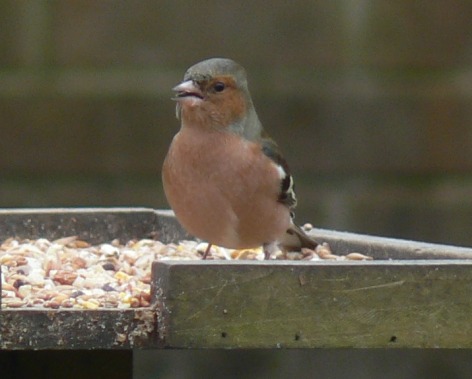
Here is a record of
Chaffinch sightings in my garden since 1998. Last year
was a disaster!
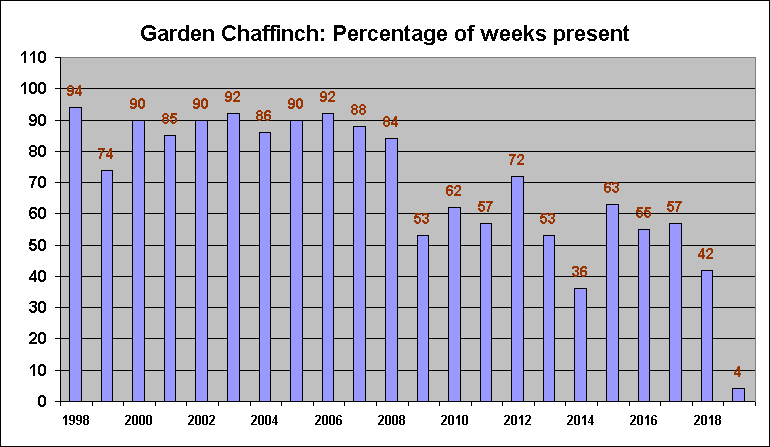
PS - I am still
waiting for a Greenfinch - no sightings for well over
a year!
FRIDAY
MARCH 5 - 2020
Brook
Meadow
What a
difference a day makes! I went over to the meadow on
this bright and sunny morning mainly to have a look
for the fungi that Terry Lay found while he and
Maurice Lillie were making a dead hedge along the west
river bank in the Seagull Lane patch a couple of days
ago. By chance, Maurice was on the meadow when I got
there, so we looked together for Terry's fungi.
Despite a good deal of scrambling and searching we
failed to locate any fungi on the west bank of the
river.
However, looking across from the east bank of the
river, I could clearly see at least four bracket fungi
on a fallen Crack Willow. From a distance, I am fairly
sure they are Common Ganoderma (Ganoderma
adsperum) - now renamed Southern Bracket
(Ganoderma australe). We have had these large
very woody bracket fungi on the meadow before, though
not often, so Terry's was a good find.
Here is a shot
looking across to the west bank with the arrow
pointing to the fungi.

Here is a close up of
the four of the fungi.
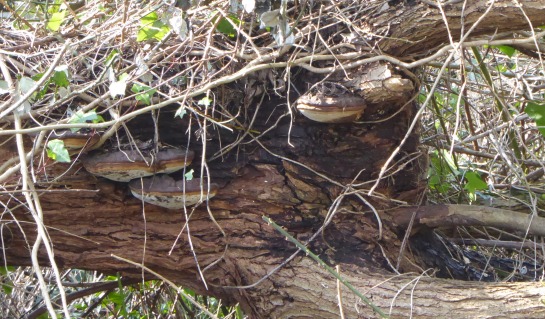
Walking along the
north path I was very pleased to see the black flower
buds on the large Ash tree with purplish male
flowers starting to show. I do not recall this tree
flowering at all last year. Maybe this is a sign of
the tree's good health? I shall keep an eye on it.

As for the younger Ash
saplings along the north path, some of them appear to
be dead or dying from Ash die-back disease.
Maurice told me that
Michael Reed had been on the meadow a few days ago to
cut off the large Crack Willow trunk that had been
leaning low over the path which meant one had to duck
down to avoid cracking one's head. The photo shows the
path now has a nice clear run with the offending
branch removed.

The river is now
running very high after yesterday's deluge and as can
be seen in the photo the water was topping the sluice
gate and streaming onto the south meadow. The two
chaps wading through the flood are from the
Environment Agency and they had just placed 'Footpath
Closed' signs at the two ends of the main south path
and padlocked the south gate. Maurice has asked them
for a key so we can open the gate once the flood
subsides. Last time there was a flood the gate was
closed for a long period after the water had gone.
Here is a shot looking south . .

Here is a shot from
the south gate showing the 'Footpath Closed' notice
and the padlocked gate.
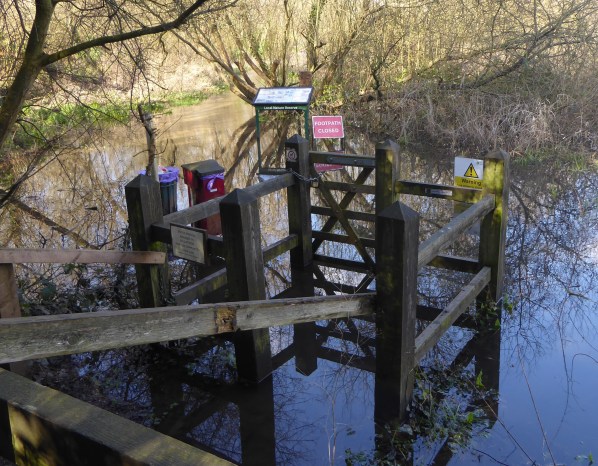
Peter
Pond
I walked down
to Peter Pond where the cob Mute Swan was busy driving
a pair of Canada Geese into the reeds in the far north
east of the pond. These geese could be the pair that
regularly nest on the centre raft on Slipper Millpond.
Maybe they fancy Peter Pond instead? But they won't be
allowed. It is swan territory!

Bridge
Road
I must
congratulate George and his colleague from Norse for
trimming the old Beech hedge along the edge of Bridge
Road car park. They could not reach some bits due to
car parking. They also trimmed various shrubs and
trees in the two shrubberies.
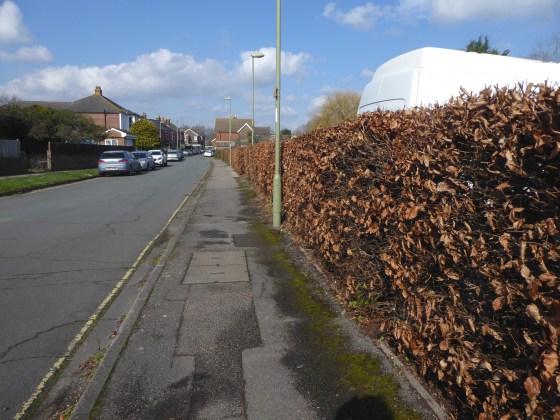
I was also pleased
with the very prompt response of the Council to my
request for the clearance of litter in the car park.
Thanks. I hope it goes on the regular litter picking
route. Meanwhile the two large clumps of Mistletoe are
looking good on the Hawthorn trees.
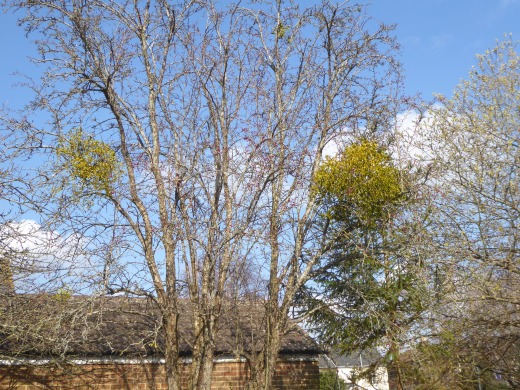
MONDAY
MARCH 2 - 2020
Langstone
Mill Pond
Peter
Milinets-Raby spent a couple of hours down Langstone
Mill Pond this morning - low tide throughout.
The highlight of the morning were the antics in the
Heronry with nine pairs up and running and one pair
with three chicks. Details below:
Nest 1: Adult male stood on top of the Holm Oak above
where the nest is located, occasionally displaying,
though only doing so in response to the new randy
couple! Herons mating . . .

Nest 2: Usually
visible this nest, the storms having taken down some
of the covering foliage. Adult sat firmly on the
nest.
Nest 4: Adult sitting on the nest
Nest 9: Adult sitting on the nest
Nest 10: Adult sitting on the nest
Nest 11: Male displaying stood on the nest. Female
standing close by.
Nest 14: Adult male on the nest. When he fiddled with
sticks to rearrange around the nest, three tiny young
could be seen. They were also calling and begging for
food

Nest 16: (NEW
construction): An actively mating pair of Grey Herons
(see photo) were building a new nest about three
metres to the left of the main colony up against the
trunk of a substantial Oak Tree. The male was in very
bright nuptial plumage.
Nest 17: (NEW construction): Another pair were
building a new nest about 10 metres behind the main
Holm Oak and viewable just to the right of the Holm
Oak. This nest is different to Nest 15 which is as yet
unoccupied and over 20/30 metres away from the main
colony.
Also on the pond were 4 male and 3 female Tufted Duck,
a calling male Reed Bunting, at least 3 Chiffchaff
were heard calling and moving north - these were
almost certainly migrants of some sort, whether the
wintering population on the move or genuine birds up
from Africa? The male Mute Swan spent the whole two
hours chasing the three remaining juveniles around the
pond, pecking at their bums. He has managed to see off
two of last years brood, only these three belligerent
teenagers to get rid of!!!
In the flooded paddock were 4 loitering Grey Heron and
a Little Egret, plus 23 Wigeon, 2 Teal a Buzzard over
and 16 Moorhen.
Off shore were 48 Shelduck, 79 Brent Geese, 142
Dunlin, 9 Red Breasted Mergansers, 6 Grey Plover, 32
Teal, 16 Wigeon and 14+ Med Gulls passing over
calling. In the pond outflow stream was a single
un-ringed Greenshank. Now, here is a question. Has the
very regular G//R + BR//- (last seen in the stream on
March 15th 2019) snuffed it? or is today's bird which
acts like the old G//R + BR//- the same bird or a new
individual taking up the vacated habitat? It is
strange that G//R + BR//- should be missing after
being so regular?
SUNDAY
MARCH 1- 2020
Brook
Meadow Workday
There was a
turn out of 10 volunteers for this morning's first
work session of the new month.

The weather was bright
and sunny with a keen westerly wind. The session was
led by Maurice Lillie who outlined the tasks for the
morning which were to continue laying gravel on the
path from the Seagull Lane gate to the north bridge
and also filling in patches along the main path south
of the north bridge.

Also to transport
barrow loads of wood chippings to the gap in the
willows between the north and the centre meadows where
considerable quantity of water collects.

For the full workday
report plus more photos go to . . . https://www.brookmeadow.org.uk/conservation-news/
Wildlife
observations
There was
plenty of Robin and Wren song around the meadow this
morning. But I was most excited to hear the distant
song of a Mistle Thrush wafting across the
meadow from the Lumley Road area. I have heard this
song from this area on several occasions over the past
month or so and hopefully this indicates a male bird
setting up its territory.
Jennifer Rye was most excited to tell me she had seen
a Kingfisher flying down river south of the
north bridge.
As for flora, the bright star-like yellow flowers of
Lesser Celandine are now well scattered around
the meadow.

I also noted Red
Dead-nettle on the north meadow and Summer
Snowflake and Primroses on the new track
created by the Environment Agency to the Lumley
Stream. This looks promising.

The flower spikes of
Butterbur are now prominent in the main area
below the seat and will be ready for counting in a
couple of weeks I reckon. On the right below is a
close-up of the attractive pink flowers.
Mergansers
on millpond
Chris Oakley
counted five Red-breasted Mergansers on the town
millpond this morning. One adult male at the seaward
end and another one at the road end. In the middle
were what appeared to be a female and two
juveniles.
For the previous month
go to . . . February
1-28